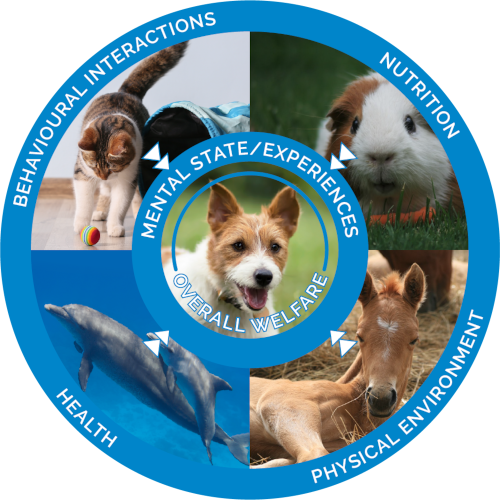In 1994, Professor David Mellor and Dr Cam Reid proposed a new model to think about animal welfare and its assessment [1]. The Five Domains Model of Animal Welfare was most recently updated in 2020 and is increasingly used globally when considering the lived experience of animals in humans’ care.
This approach allows for consideration of both negative and positive experiences that arise from physical and functional factors, which affect the overall mental state and welfare of the individual animal. Over the past 20 years this paradigm has been widely adopted as a tool for assessing the welfare impacts of research procedures, pest animal control methods, and other interventions in animals’ lives.

The Five Domains explores the mental state of an animal in detail and acknowledges that for every physical aspect that is affected, there may be an accompanying emotion or subjective experience that may also affect welfare. This is useful in terms of reinforcing the message that mental experiences are equally important as physical vitality for animals to thrive.
One of the most important strengths of the Five Domains is the clarity it provides that merely minimising or resolving negative physical or mental states does not necessarily result in positive welfare, but may only provide, at best, a neutral state. To have a good life, one where positive welfare experiences are enjoyed, animals need more than this.
To help ensure animals have a ‘a good life’ they must have the opportunity to have positive experiences, such as anticipation, meaningful social connection, satisfaction, and satiation. To enable this, those responsible for the care of animals need to provide them with opportunities for interactions (with their environment, people, and other animals) that not only allow but encourage animals to make choices and express behaviours that are rewarding to them. This shift in understanding is the basis for the Five Domains model incorporating positive welfare states [2, 3, 4]. You can read about this in detail here.
Thus, the Five Domains provides a comprehensive and structured way of considering the wellbeing of an individual or group of animals in a particular situation, with a strong focus on positive mental experiences. The Five Domains also allows us to extend our thinking beyond the historical Five Freedoms of animal welfare to place even greater emphasis on encouraging positive experiences and recognising the emotional needs of individual animals, in addition to minimising negative experiences.
References
[1] Mellor DJ & Reid CSW (1994) Concepts of animal well-being and predicting the impact of procedures on experimental animals. In Improving the Well-Being of Animals in the Research Environment; Australian and New Zealand Council for the Care of Animals in Research and Teaching (ANZCCART): Glen Osmond, SA, Australia, pp. 3–18.
[2] Mellor DJ (2017) Operational details of the Five Domains Models and its key applications to the assessment and management of animal welfare. Animals 7(8):60. doi:10.3390/ani7080060
[3] Mellor DJ & Beausoleil NJ (2015) Extending the ‘Five Domains’ model for animal welfare assessment to incorporate positive welfare states. Animal Welfare 24:241–253. doi: 10.7120/09627286.24.3.241.
[4] Mellor DJ, Beausoleil NJ, Littlewood KE et al (2020) The 2020 Five Domains Model: Including Human-Animal Interactions in Assessments of Animal Welfare. Animals 10(10):1870. doi: 10.3390/ani10101870.
